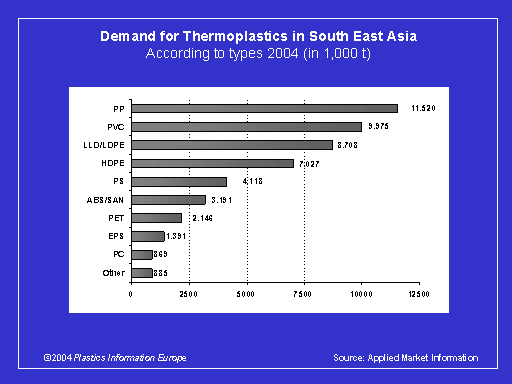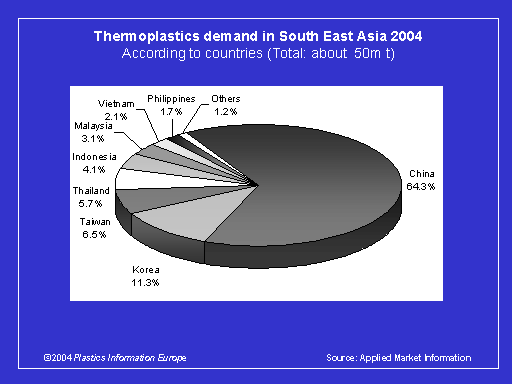SOUTHEAST ASIA
Thermoplastics to grow 6% in 2004 / China accounts for 65% of demand / New AMI study
The Southeast Asian market for thermoplastics will grow by more than 6% to nearly 50m t in 2004, thanks largely to soaring Chinese demand, the British market research group Applied Market Information (AMI, GB Bristol BS1 3QP; www.amiplastics.com) says in a report just published. The region has become the clear global leader in thermoplastics, ahead of both Europe and North America, AMI notes.
The report says the market is being driven by China, which accounts for almost 65% of Asia´s polymer demand and about a third of production – without China, growth would be only 2.5%. AMI says that the strength of China could ultimately undermine the plastics industry in the remainder of Southeast Asia and that government measures to dampen the country´s runaway economic growth may have “limited” impact on polymer demand. Overall growth for polymers in China in 2004 is expected to be close to the 9% achieved in 2003, says the report.
According to AMI, China´s “huge” dependency on imported polymers means that its markets have become integrated internationally and follow global trends. Prices of domestically produced and imported materials are being driven higher by increasing international prices for raw materials including oil and naphtha.
With the exception of Vietnam (which has developed from a much lower base), China has consistently been the fasted growing market in the region for over a decade, the report says. The more developed economies of South Korea, Taiwan and Singapore are seeing their markets mature and plastics processing moving into China, Vietnam and other low cost locations.
Book Service: “AMI´s 2004 South East Asian Plastics Industry Report”, 2004, 216 pages, A4 soft cover, EUR 720.00 + VAT: PIE-No. B 46792. • “The Thermoplastics Compounding Industry in Asia”, 2004, 125 pages, A4 soft cover, EUR 720.00 + VAT: PIE-No. B 46793.
The report says the market is being driven by China, which accounts for almost 65% of Asia´s polymer demand and about a third of production – without China, growth would be only 2.5%. AMI says that the strength of China could ultimately undermine the plastics industry in the remainder of Southeast Asia and that government measures to dampen the country´s runaway economic growth may have “limited” impact on polymer demand. Overall growth for polymers in China in 2004 is expected to be close to the 9% achieved in 2003, says the report.
According to AMI, China´s “huge” dependency on imported polymers means that its markets have become integrated internationally and follow global trends. Prices of domestically produced and imported materials are being driven higher by increasing international prices for raw materials including oil and naphtha.
With the exception of Vietnam (which has developed from a much lower base), China has consistently been the fasted growing market in the region for over a decade, the report says. The more developed economies of South Korea, Taiwan and Singapore are seeing their markets mature and plastics processing moving into China, Vietnam and other low cost locations.
Book Service: “AMI´s 2004 South East Asian Plastics Industry Report”, 2004, 216 pages, A4 soft cover, EUR 720.00 + VAT: PIE-No. B 46792. • “The Thermoplastics Compounding Industry in Asia”, 2004, 125 pages, A4 soft cover, EUR 720.00 + VAT: PIE-No. B 46793.
 | |
 | |
09.12.2004 Plasteurope.com [201648]
Published on 09.12.2004

 German version of this article...
German version of this article...